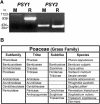Gene duplication in the carotenoid biosynthetic pathway preceded evolution of the grasses
- PMID: 15247400
- PMCID: PMC519089
- DOI: 10.1104/pp.104.039818
Gene duplication in the carotenoid biosynthetic pathway preceded evolution of the grasses
Abstract
Despite ongoing research on carotenoid biosynthesis in model organisms, there is a paucity of information on pathway regulation operating in the grasses (Poaceae), which include plants of world-wide agronomic importance. As a result, efforts to either breed for or metabolically engineer improvements in carotenoid content or composition in cereal crops have led to unexpected results. In comparison to maize (Zea mays), rice (Oryza sativa) accumulates no endosperm carotenoids, despite having a functional pathway in chloroplasts. To better understand why these two related grasses differ in endosperm carotenoid content, we began to characterize genes encoding phytoene synthase (PSY), since this nuclear-encoded enzyme appeared to catalyze a rate-controlling step in the plastid-localized biosynthetic pathway. The enzyme had been previously associated with the maize Y1 locus thought to be the only functional gene controlling PSY accumulation, though function of the Y1 gene product had never been demonstrated. We show that both maize and rice possess and express products from duplicate PSY genes, PSY1 (Y1) and PSY2; PSY1 transcript accumulation correlates with carotenoid-containing endosperm. Using a heterologous bacterial system, we demonstrate enzyme function of PSY1 and PSY2 that are largely conserved in sequence except for N- and C-terminal domains. By database mining and use of ortholog-specific universal PCR primers, we found that the PSY duplication is prevalent in at least eight subfamilies of the Poaceae, suggesting that this duplication event preceded evolution of the Poaceae. These findings will impact study of grass phylogeny and breeding of enhanced carotenoid content in an entire taxonomic group of plant crops critical for global food security.
Figures





References
-
- Bartley GE, Scolnik PA (1993) cDNA cloning, expression during development, and genome mapping of Psy2, a second tomato gene encoding phytoene synthase. J Biol Chem 268: 25718–25721 - PubMed
-
- Bendich A, Olson J (1989) Biological actions of carotenoids. FASEB J 3: 1927–1932 - PubMed
-
- Bird CR, Ray JA, Fletcher JD, Boniwell JM, Bird AS, Teulieres C, Blain I, Bramley PM, Schuch W (1991) Using antisense RNA to study gene function: inhibition of carotenoid biosynthesis in transgenic tomatoes. Biotechnology 9: 635–639
-
- Blott S, Kim J-J, Moisio S, Schmidt-Kuntzel A, Cornet A, Berzi P, Cambisano N, Ford C, Grisart B, Johnson D, et al (2003) Molecular dissection of a quantitative trait locus: a phenylalanine-to-tyrosine substitution in the transmembrane domain of the bovine growth hormone receptor is associated with a major effect on milk yield and composition. Genetics 163: 253–266 - PMC - PubMed
Publication types
MeSH terms
Substances
Associated data
- Actions
- Actions
- Actions
- Actions
- Actions
- Actions
- Actions
- Actions
- Actions
- Actions
- Actions
- Actions
- Actions
- Actions
- Actions
- Actions
- Actions
- Actions
- Actions
- Actions
- Actions
- Actions
- Actions
- Actions
- Actions
- Actions
- Actions
- Actions
- Actions
- Actions
- Actions
- Actions
- Actions
- Actions
- Actions
- Actions
- Actions
- Actions
- Actions
- Actions
- Actions
Grants and funding
LinkOut - more resources
Full Text Sources
Molecular Biology Databases
Research Materials

